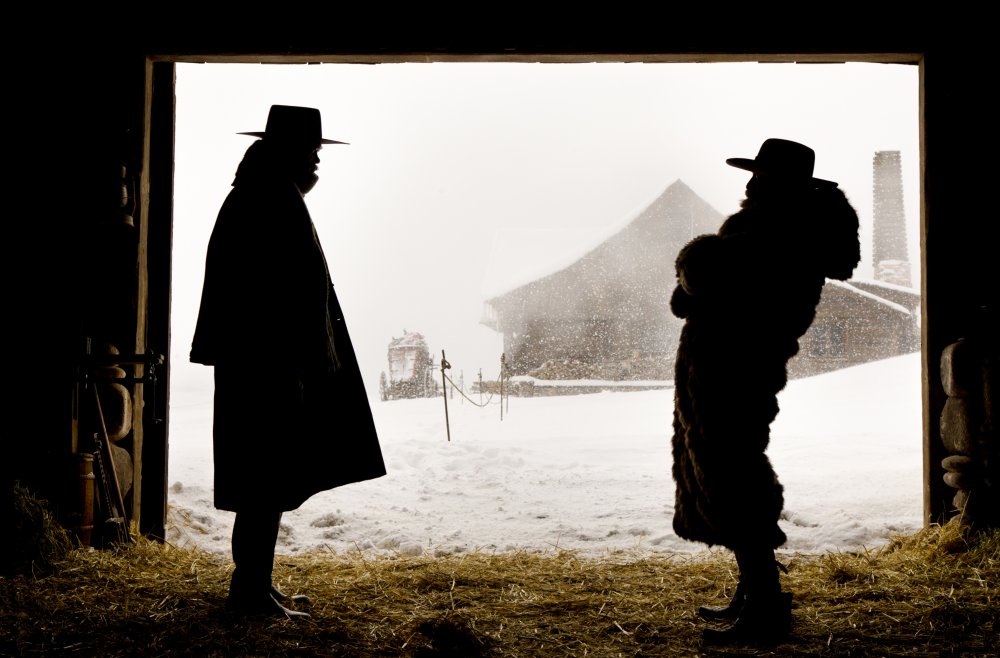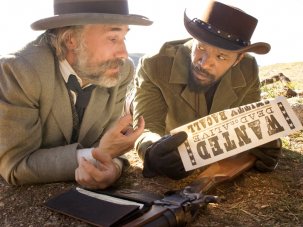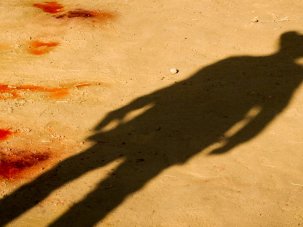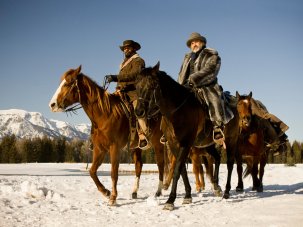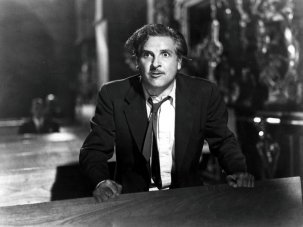Unarguably a breed of charismatic megafauna unto himself, Quentin Tarantino has for many become an inviolate quantity in film culture – an artist who creates his own meta-pulp moviescapes, saturated with self-knowing Godardian cine-love and as distinctive from his contemporaries’ work as surf rock is from elevator music. This is the yolk of auteurism – loving the art for who the artist uniquely is, for the tonal integrity that demands you watch his movies his way, and as much for what the films aren’t (faddish, patronising, market-calculated, unTarantino-esque) as for what they are. Nobody does what Tarantino does, and that alone, in a world of copycats and sequels and rip-offs, makes him priceless.
USA 2015
Certificate 18
Roadshow running time 187m approx. (including 12m intermission)
General release running time 167m approx.
Director Quentin Tarantino
Cast
Major Marquis Warren Samuel L. Jackson
John Ruth, ‘The Hangman’ Kurt Russell
Daisy Domergue Jennifer Jason Leigh
Chris Mannix Walton Goggins
Bob Demian Bichir
Oswaldo Mobray Tim Roth
Joe Gage Michael Madsen
General Sanford Smithers Bruce Dern
O.B. Jackson James Parks
Minnie Mink Dana Gourrier
Six-Horse Judy Zoë Bell
Ed Lee Horsley
Sweet Dave Gene Jones
Charlie Keith Jefferson
Chester Charles Smithers Craig Stark
Gemma Belinda Owino
Jody Channing Tatum
Dolby Digital
In Colour
2.76:1 [Ultra Panavision 70]
UK release date 8 January 2016
Distributor Entertainment Film Distribution
thehatefuleight.com
► Trailer
But thinking of him this way, as cinephilic as it is, leaves out the essential matter of whether or not Tarantino being Tarantino is always a good thing, and whether the movies are quite as much fun to watch, or as brilliantly self-reflexive/subversive, as the filmmaker thinks they are. Django Unchained (2012) begged the question, and now The Hateful Eight, a kind of post-anti-western, makes it inevitable. Essentially a protracted TV play set in a snowbound cabin occupied by a motley (nine and then ten, not eight) assortment of bounty hunters, outlaws, Confederate vets and other frontier types, the film seems almost conceived to test the tensile strength of our Tarantino ardour and our patience for the man’s less enlightened tastes.
Self-consciousness isn’t the issue; in fact, the Lean-esque ‘overture’ and the intermission that endeavours to ‘eventise’ the otherwise modest film register as fond nostalgia, and give Ennio Morricone’s original score a chance to unleash its dramatic roar.
Unfortunately, the epic significance the music promises is never delivered. (Should it have been played in air quotes?) Rather, the frontier expanses where bountymen Samuel L. Jackson and Kurt Russell meet and squabble about a coach ride, a prisoner (a feral Jennifer Jason Leigh, forever getting punched in the face) and a letter from Lincoln, are soon relinquished for the cluttered cabin inn, which is as absurdly large as Sergio Leone’s frontier farmhouses. Other occupants – Bruce Dern’s taciturn Southern racist, Tim Roth’s chortling dandy, Demián Bichir’s watchful Mexican, Michael Madsen’s Madsen-ish loner, Walton Goggins’s loudmouth Johnny Reb – bandy about, probing everyone else’s reputation and disputing history. In by-now predictable Tarantino fashion, nearly everyone is revealed to have a secret agenda, a secret identity, or both.
In formal terms, Lars von Trier’s fiercely ironic Dogville (2003) might come to mind, but the comparison only backlights The Hateful Eight’s deficit of ideas. The means by which Tarantino’s stagebound drama-onion is peeled are limited almost entirely to expository dialogue – which, in the man’s late fashion, is self-reverently repetitious, over-articulate and methodical. (“Let’s slow it way down,” Jackson says late in the game, as he plays detective in what feels like a Murder by Death riff.) Characters pair off for private discussions, as in a stage drama. Entire scenes of chitchat and eating serve as distended slow burns to sudden splashes of bloodshed. Characters explain things we already understand two or more times, while the almost obligatory doubling flashbacks rewrite what we’ve seen but do so in mostly unsurprising ways.
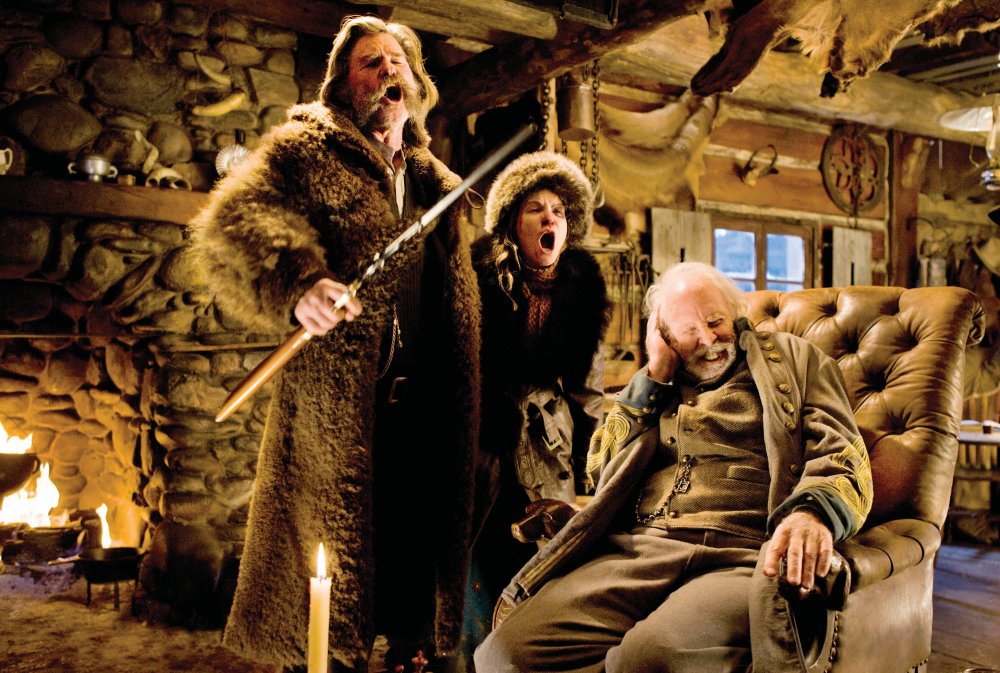
Paint it blue: Kurt Russell, Jennifer Jason Leigh and Bruce Dern
Of course, the threads are eventually resolved, or abruptly severed, with explosions of gore. The actors more often bark than talk, and “nigger” is hollered and hissed more frequently than in all of Tarantino’s other movies combined.
In Tarantinoland, these purely textural cavils are all pluses – either you’re in for the indulgences and excesses or you don’t come. Indeed, you go off the QT reservation entirely if you dare to wonder whether his characters shouldn’t just talk in circles for exactly as long as the filmmaker wants them to, or if hilariously bloodsoaked homicide is the only way he knows to end a story. Sure, you can offer that The Hateful Eight isn’t as piquant as Inglourious Basterds (2009) or as seasoned as Jackie Brown (1997), but to suggest that its redundancies, bad habits and glacial pacing are intrinsically problematic is simply not to get what’s there to be gotten. Is it? Or have we raised the bar far above the B-movie hinterlands where Tarantino prefers to remain?
I’m willing to consider either case – it all depends on how you frame what Tarantino is trying to do. Meta-cinematic rogue-revolutionary or narcissistic goofball? Anyway, like most of Kubrick, Tarantino’s films usually require re-viewing; their first impressions can be disappointing. (The only oeuvre entry that this reviewer didn’t need to see twice – ie appreciated immediately – was Reservoir Dogs.) But it may be time to admit frustrated irritation with Tarantino’s evolving voice, even if it means questioning a beloved and hyper-literate hipster auteur, in an American desert of original perspectives, whose work consists of 95 per cent dialogue and no CGIs whatsoever. Forgive us for being conflicted.
In the February 2016 issue of Sight & Sound
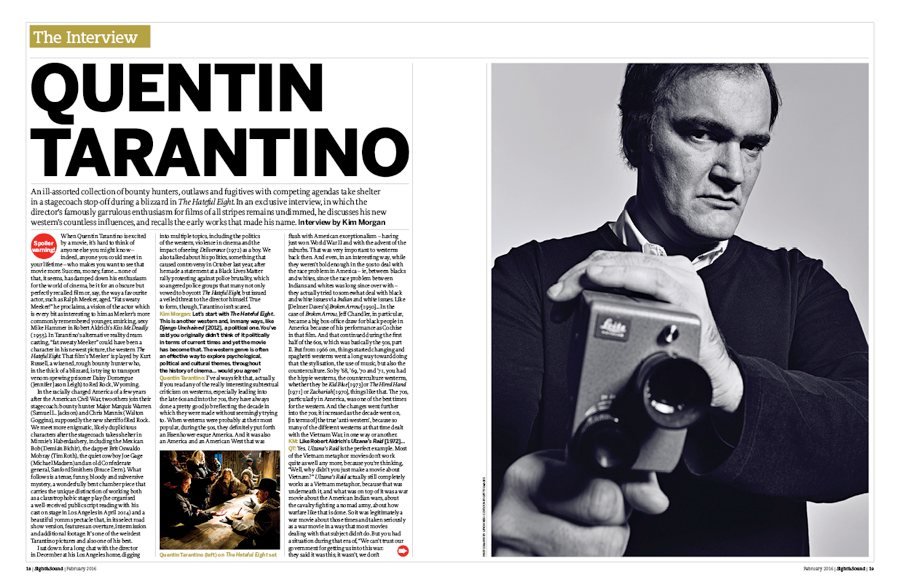
The Interview: Quentin Tarantino
An ill-assorted collection of bounty hunters, outlaws and fugitives with competing agendas take shelter in a stagecoach stop-off during a blizzard in The Hateful Eight. In an exclusive interview, in which the director’s famously garrulous enthusiasm for films of all stripes remains undimmed, he discusses his new western’s countless influences, and recalls the early works that made his name. Interview by Kim Morgan.
-
Sight & Sound: the February 2016 issue
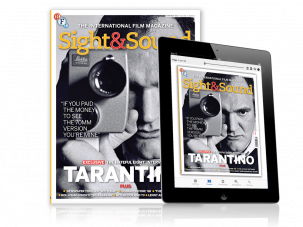
Tarantino on Tarantino, Kent Jones on the best of Jean-Luc Godard, Hou Hsiao-Hsien’s ravishing The Assassin, Tom McCarthy’s Spotlight, Lenny...
-
The Digital Edition and Archive quick link
Log in here to your digital edition and archive subscription, take a look at the packages on offer and buy a subscription.




